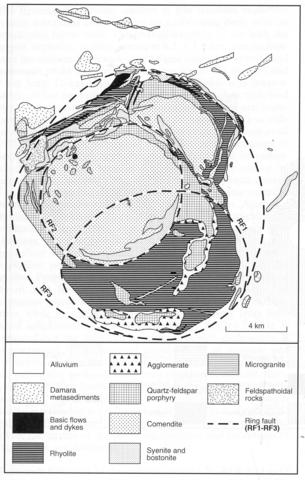stripes
Paresis is an eroded volcanic complex of about 18x15 km comprising a central, circular area 9 km in diameter of inward dipping rhyolitic flows intruded marginally by syenites, and northern and southern arcuate marginal areas built of inward dipping dykes, steeply dipping rhyolite flows and agglomerates (Siedner, 1965a, Plate IV). An outer broken chain of low hills is principally composed of microgranites. The volcanic activity can be divided into an earlier predominantly extrusive phase, the products of which were preserved through cauldron subsidence, and a phase of emplacement of felsic ring-dykes and stocks. The extrusive rocks are predominantly rhyolitic and three cycles were distinguished by Siedner (1965a) characterised respectively by feldspar rhyolite, quartz-feldspar porphyry and comendite. Each cycle involved the building of a stratovolcano and intrusion of dykes. The first and third cycles were terminated by cauldron subsidence both these cauldrons being encompassed by a final collapse along a ring-fault. Rhyolites form 90% of the complex and appear to have been emplaced as ash flows which were extensively welded. Mafic minerals in rocks of the first two cycles cannot be identified because of alteration, but in the comendites glomeroporphyritic aggregates of riebeckite, sometimes accompanied by hornblende and aegirine, occur set in a fine groundmass of quartz and alkali feldspar. Micropegmatites with riebeckite margins are widely developed. In the central area 13 endogenous domes have been mapped, all of which are comendite (Siebner, 1965a). Thin basalt flows are intercalated with the rhyolites and occur predominantly close to the outer ring fault. Siedner (1965a) believed that the basalts did not originate in the Paresis centre but are contemporary, but genetically unrelated, Stormberg (Karoo) flows. The rhyolitic volcanism was succeeded by an intrusive phase, to which about 10% of the presently exposed rocks belong, which includes syenites, microgranites and foyaites. The first, and most abundant, phase, which forms small plugs and dykes, was a quartz syenite of alkali feldspar, 5-15% quartz, clinopyroxene, fayalitic olivine and some hornblende. On the northwestern margin of the complex is a 3x1.3 km intrusion with an outer ring of foyaite and an inner area, possibly a plug, of phonolite, which is itself cut by tinguaite. Around this intrusion of feldspathoidal rocks metasomatism has resulted in the clouding of feldspar and introduction of aegirine, magnetite, riebeckite and fluorite. Little petrographic and no mineralogical data have been located but Siedner (1965b) gives chemical data, including some trace elements, for a broad range of rocks, and there are five rock analyses and oxygen isotope data in Harris (1995).
HARRIS, C. 1995. Oxygen isotope geochemistry of the Mesozoic anorogenic complexes of Damaraland, northwest Namibia: evidence for crustal contamination and its effect on silica saturation. Contributions to Mineralogy and Petrology, 122: 308-21.MANTON, W.I. and SIEDNER, G. 1967. Age of the Paresis complex, South-West Africa. Nature, London, 216: 1197-8.MILNER, S.C., LE ROEX, A.P. and O’CONNOR, J.M. 1995. Age of Mesozoic igneous rocks in northwestern Namibia, and their relationship to continental breakup. Journal of the Geological Society of London, 152: 97-104.SIEDNER, G. 1965a. Structure and evolution of the Paresis igneous complex, South West Africa. Transactions and Proceedings of the Geological Society of South Africa, 68: 177-202.SIEDNER, G. 1965b. Geochemical features of a strongly fractionated alkali igneous suite. Geochimica et Cosmochimica Acta, 29: 113-37.SIEDNER, G. and MILLER, J.A. 1968. K-Ar age determinations on basaltic rocks from South-West Africa and their bearing on continental drift. Earth and Planetary Science Letters, 4: 451-8.

